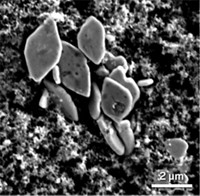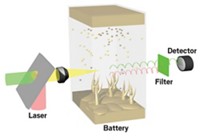Advertisement
Grab your lab coat. Let's get started
Welcome!
Welcome!
Create an account below to get 6 C&EN articles per month, receive newsletters and more - all free.
It seems this is your first time logging in online. Please enter the following information to continue.
As an ACS member you automatically get access to this site. All we need is few more details to create your reading experience.
Not you? Sign in with a different account.
Not you? Sign in with a different account.
ERROR 1
ERROR 1
ERROR 2
ERROR 2
ERROR 2
ERROR 2
ERROR 2
Password and Confirm password must match.
If you have an ACS member number, please enter it here so we can link this account to your membership. (optional)
ERROR 2
ACS values your privacy. By submitting your information, you are gaining access to C&EN and subscribing to our weekly newsletter. We use the information you provide to make your reading experience better, and we will never sell your data to third party members.
Analytical Chemistry
Watching Battery Chemistry With MRI
Electrochemistry: Magnetic resonance imaging could help scientists better understand the chemical workings inside batteries
by Alexander Hellemans
September 6, 2013

To help design safe, long-lasting batteries, researchers would like to watch a battery’s electrochemistry in real time as it charges and discharges. Now a team has used magnetic resonance imaging to watch a zinc-air battery in action (J. Phys. Chem. Lett. 2013, DOI: 10.1021/jz401415a).
Most studies of battery performance use measurements of overall function, such as storage capacity or lifetime, to assess the effects of changes to battery design. But such studies don’t allow materials scientists to follow the movement of chemical species in a battery’s electrolyte or to understand side reactions that impede optimal battery performance. Imaging techniques could offer a solution, allowing scientists to produce a detailed spatial map of the distribution of chemical species in an electrochemical cell.
A group, led by Melanie M. Britton of the University of Birmingham in the U.K. and Maria Forsyth of Deakin University in Australia, wanted to use MRI to make such maps. Previously other researchers had used MRI to monitor metal deposits that grow on electrodes during a battery’s lifetime.
Most material scientists have avoided using the imaging technique to analyze batteries, because metal in the batteries can disrupt how MRI instruments work, Britton says. The instruments apply a magnetic field across the object being analyzed and require a uniform field to produce clean images. Metal objects create local changes within the field. To apply MRI to batteries the researchers had to eliminate the distortion that metal electrodes produce.
Britton and Forsyth’s team found that by placing the battery in a specific orientation inside the MRI instrument, they could collect distortion-free images. They needed to align the metal electrodes perpendicular to the direction of magnetic field, but parallel to the instrument’s radio wave pulses.
The team tested the method on a complete zinc-air battery with zinc and titanium electrodes as it discharged over 47 hours. With the MRI instrument, the researchers could measure the concentration of hydroxide ions, which served as the electrolyte, across the cell. Through the resulting concentration maps, they could recreate the electrochemical reactions occurring at each electrode.
The new technique is useful, says Alexej Jerschow, a chemist at New York University, but the researchers need to better understand an artifact created by the magnetic field. The MRI’s magnetic field affects the movement of ions in the electrolyte, even when the battery is not discharging. The team thinks that the strong field—about 7 Tesla—induces a current in the zinc electrode, which triggers electrochemistry between the electrode and electrolyte.
Britton and Forsyth are refining the technique and looking for ways to remove this artifact from future experiments. Still Britton thinks the MRI technique could help others understand how changes to battery cell design affect the underlying electrochemistry. “This was a proof of concept, showing the extraordinary potential of MRI to follow these electrochemical processes,” she says.





Join the conversation
Contact the reporter
Submit a Letter to the Editor for publication
Engage with us on Twitter